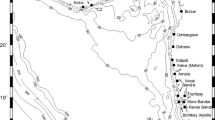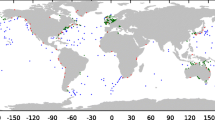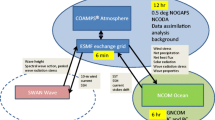Abstract
Terrain-following ocean models are being used to simulate baroclinic tides and provide estimates of the tidal fields for circulation and mixing studies. These models have successfully reproduced elevations with most of the remaining inaccuracies attributed to topographic errors; however, the replication of barotropic and baroclinic velocity fields has not been as robust. Part of the problem is the lack of an adequate observational dataset in the simulated regions to compare the models. This problem was addressed using a dataset collected during the Flow over Abrupt Topography initiative at Fieberling Guyot. To evaluate the capability of the Regional Ocean Model System (ROMS) to simulate baroclinic tidal velocities, the combined tides for four constituents, M2, S2, K1, and O1, were modeled over Fieberling Guyot. Model inputs, numerical schemes, and parameterizations were varied to improve agreement with observations. These included hydrography, horizontal resolution, and the vertical mixing parameterization. Other factors were evaluated but are not included in this paper. With the best case, semidiurnal baroclinic tides were well replicated with RMS differences between the model estimates and the observations of 1.85 and 0.60 cm s−1 for the major axes of the tidal ellipses for M2 and S2, respectively. However, diurnal K1 baroclinic tides were poorly simulated with RMS differences of 4.49 cm s−1. In the simulations, the K1 baroclinic tides remained bottom-trapped unlike the observed fields, which had free waves due to the contribution of the mean velocity to the potential vorticity. The model did not adequately simulate the mean velocity, and the K1 tides remained trapped. A resolution of 1 km most accurately reproduced the major axes and mean velocities; however, a 4-km resolution was sufficient for a qualitative estimate of where baroclinic tidal generation occurred. Nine vertical mixing parameterizations were compared. The vertical mixing parameterization was found to have minor effects on the velocity fields, with most effects occurring over the crown of guyot and in the lower water column; however, it had dramatic effects on the estimation of vertical diffusivity of temperature. Although there was no definitive best performer for the vertical mixing parameterization, several parameterizations could be eliminated based on comparison of the vertical diffusivity estimates with observations. The best performers were Mellor–Yamada and three generic length scale schemes.










Similar content being viewed by others
References
Beckmann A, Haidvogel DB (1997) A numerical simulation of flow at Fieberling Guyot. J Geophys Res 102:5595–5613
Brink KH (1991) Coastal-trapped waves and wind-driven currents over the continental shelf. Annu Rev Fluid Mech 23:399–412
Brink KH (1995) Tidal and lower frequency currents above Fieberling Guyot. J Geophys Res 100:10817–10832
Burchard H, Bolding K (2001) Comparative analysis of four second-moment turbulence closure models for the oceanic mixed layer. J Phys Oceanogr 31:1943–1968
Burchard H, Petersen O, Rippeth TP (1998) Comparing the performance of the Mellor–Yamada and the k−ɛ two-equation turbulence models. J Geophys Res 103:10543–10554
Codiga DL (1997) Trapped-wave modification and critical surface formation by mean flow at a seamount with application at Fieberling Guyot. J Geophys Res 102:23025–23039
Cummins PF, Oey L-Y (1997) Simulation of barotropic and baroclinic tides off northern British Columbia. J Phys Oceanogr 27:762–781
Egbert GD, Erofeeva S (2002) Efficient inverse modeling of barotropic ocean tides. J Atmos Ocean Technol 19:22475–22502
Eriksen CC (1991) Observations of amplified flows atop a large seamount. J Geophys Res 96:15227–15236
Eriksen CC (1998) Internal wave reflection and mixing at Fieberling Guyot. J Geophys Res 103:2977–2994
Ezer T, Arango H, Shchepetkin AF (2002) Developments in terrain-following ocean models: Intercomparisons of numerical aspects. Ocean Model 4:249–267
Flather RA, Proctor R (1983) Prediction of North Sea storm surge using numerical models: recent developments in the UK, in North Sea dynamics. In: Sundermann J, Lenz W (eds) Springer, Berlin Heidelberg New York
Foreman MGG (1978) Manual for tidal current analysis and prediction. Pacific Marine Science Report No. 78-6. Institute of Ocean Sciences, Patricia Bay, Sidney, B.C., pp 70
Ganachaud A, Wunsch C (2004) Improved estimates of global ocean circulation, heat transport and mixing from hydrographic data. Nature 410:240–242
Gargett AE, Holloway G (1984) Dissipation and diffusion by internal wave breaking. J Mar Res 42:15–27
Garrett C (2003) Internal tides and ocean mixing. Science 301:1858–1859
Holloway PE (1996) A numerical model of internal tides with application to the Australian North West Shelf. J Phys Oceanogr 26:21–37
Holloway PE (2001) A regional model of the semi-diurnal internal tide on the Australian North West Shelf. J Geophys Res 106:19625–19638
Holloway PE, Pelinovsky E, Talipova T (1999) A generalized Korteweg–de Vries model of internal tide transformation in the coastal zone. J Geophys Res 104:18333–18350
Jayne SR, St. Laurent LC (2001) Parameterizing tidal dissipation over rough topography. Geophys Res Lett 23:2101–2104
Jones WP, Launder BE (1972) The prediction of laminarization with a two equation model of turbulence. Int J Heat Mass Transfer 15:1–32
Kunze E, Toole JM (1995) Fine- and microstructure observations of trapped diurnal oscillations atop Fieberling Seamount. In: Müller P, Henderson D (eds) Topographic effects in the ocean. Proceedings of Aha Huliko, a Hawaiian Winter Workshop. School of Ocean and Earth Science and Technology, University of Hawaii, Honolulu, pp 15–42
Kunze E, Toole JM (1997) Tidally driven vorticity, diurnal shear, and turbulence atop Fieberling seamount. J Phys Oceanogr 28:811–814
Large WG, Gent PR (1999) Validation of vertical mixing in an equatorial ocean model using large eddy simulations and observations. J Phys Oceanogr 29:449–464
Legg S (2004a) Internal tides generated on a corrugated continental slope. Part I: cross-slope barotropic forcing. J Phys Oceanogr 34:156–173
Legg S (2004b) Internal tides generated on a corrugated continental slope. Part II: along-slope barotropic forcing. J Phys Oceanogr 34:1824–1838
Levitus S, Boyer T (1994) World Ocean Atlas 1994 volume 4: temperature. NOAA Atlas NESDIS 4, U.S. Department of Commerce, Washington, D.C.
LOAM (2002) The Lamont ocean atmosphere mixed layer model, www-documentation, Lamont Doherty Earth Observatory, http://rainbow.ldeo.columbia.edu/climategroup/loam/, ed Naik
Merrifield MA, Holloway PE (2002) Model estimates of M2 internal tide energetics at the Hawaiian Ridge. J Geophys Res 107:1029/2001JC000996
Merrifield MA, Holloway PE, Johnson TMS (2001) The generation of internal tides at the Hawaiian Ridge. Geophys Res Lett 28:559–562
Mellor GL, Yamada T (1982) Development of a turbulence closure model for geophysical fluid problems. Rev Geophys Space Phys 20:851–875
Middleton JH, Denniss T (1993) The propagation of tides near the critical latitude. Geophys Astrophy Fluid Dyn 38:1–13
Munk W, Wunsch C (1998) The moon and mixing: abyssal recipes II. Deep-Sea Res 45:1977–2010
Niwa Y, Hibiya T (2001) Numerical study of the spatial distribution of the M2 internal tide in the Pacific Ocean. J Geophys Res 106:22441–22450
Noble MA, Brink KH, Eriksen CC (1994) Diurnal-period currents trapped above Fieberling Guyot: observed characteristics and model comparison. Deep-Sea Res 41:643–658
Pacanowski RC, Philander G (1981) Parameterization of vertical mixing in numerical models of the tropical ocean. J Phys Oceanogr 11:1442–1451
Pawlowicz R, Beardsley R, Lentz S (2002) Classical tidal harmonic analysis with error analysis in MATLAB using T-Tide. Comput Geosci 28:929–937
Peters J, Gregg MC, Toole JM (1988) On the parameterization of equatorial turbulence. J Geophys Res 93:1199–1218
Petruncio ET (1996) Observations and modeling of the internal tide in a submarine canyon. PhD dissertation for Naval Postgraduate School, Monterey, California
Polzin KL, Toole JM, Ledwell JR, Schmitt RW (1997) Spatial variability of turbulent mixing in the abyssal ocean. Science 276:93–96
Robertson R (2001) Internal tides and baroclinicity in the southern Weddell Sea: part I: model description, and comparison of model results to observations. J Geophys Res 106:27001–27016
Robertson R (2005a) Barotropic and baroclinic tides in the Ross Sea. Antarctic Science 17:107–120
Robertson R (2005b) Baratropic and baroclinic tides in the Weddell Sea. Antarct Sci 17:461–474
Robertson R (2005c) M2 baroclinic tides in the Indonesian Seas. Oceanography 18:62–73
Robertson R, Beckmann A, Hellmer H (2003) Tidal dynamics in the Ross Sea. Antarct Sci 15:41–46
Rudnick DL, Boyd TJ, Brainard RE, Carter GS, Egbert GD, Gregg MC, Holloway PE, Klymak JM, Kunze E, Lee CM, Levine MD, Luther DS, Martin JP, Merrifield MA, Moum JN, Nash JD, Pinkel R, Rainville L, Sanford TB (2003) From tides to mixing along the Hawaiian Ridge. Science 201:344–357
Sharman RD, Wurtele MG (2004) Three-dimensional structure of forced gravity waves and lee waves. J Atmos Sci 61:664–681
Shchepetkin AF, McWilliams JC (2003) A method for computing horizontal pressure gradient force in an ocean model with non-aligned vertical coordinates. J Geophys Res 108:35.1–35.34. DOI 10:1029/2001 JC001047
Simpson JH, Crawford WR, Rippeth TP, Campbell AR, Check JVS (1996) The vertical structure of turbulent dissipation in shelf seas. J Phys Oceanogr 26:1579–1590
Smyth WD, Skyllingstad ED, Crawford GB, Wisjesekera H (2002) Nonlocal fluxes and Stokes drift effects in the K-profile parameterization. Ocean Dyn 52:104–115
Toole JM, Schmitt RW, Polzin KL (1997) Near-boundary mixing above the flanks of a mid-latitude seamount. J Geophys Res 102:947–959
Umlauf L, Burchard H (2003) A generic length-scale equation for geophysical turbulence. J Mar Res 61:235–265
Umlauf L, Burchard H, Hutter K (2003) Extending the κ−ω turbulence model toward oceanic applications. Ocean Model 5:195–218
Warner JC, Sherwood CR, Arango HG, Butman B, Signell RP (2005) Performance of four turbulence closure methods implemented using a generic length scale method. Ocean Model 8:81–113
Acknowledgements
Thanks are due to Marlene Noble, Charles Eriksen, John Toole, Eric Kunze, and Kenneth Brink for supplying me with the data for Fieberling Guyot. Valuable information and insight into the vertical mixing parameterizations was gained during the discussions with William Large, and I am grateful for his input. This study was funded by (Office of Polar Programs) OPP grant OPP-00-3425 of the National Science Foundation. This is Lamont publication 6864. Any opinions, findings, and conclusions or recommendations expressed in this material are those of the authors and do not necessarily reflect the views of the NSF.
Author information
Authors and Affiliations
Corresponding author
Additional information
Responsible Editor Rosemary Morrow
Rights and permissions
About this article
Cite this article
Robertson, R. Modeling internal tides over Fieberling Guyot: resolution, parameterization, performance. Ocean Dynamics 56, 430–444 (2006). https://doi.org/10.1007/s10236-006-0062-5
Received:
Accepted:
Published:
Issue Date:
DOI: https://doi.org/10.1007/s10236-006-0062-5




